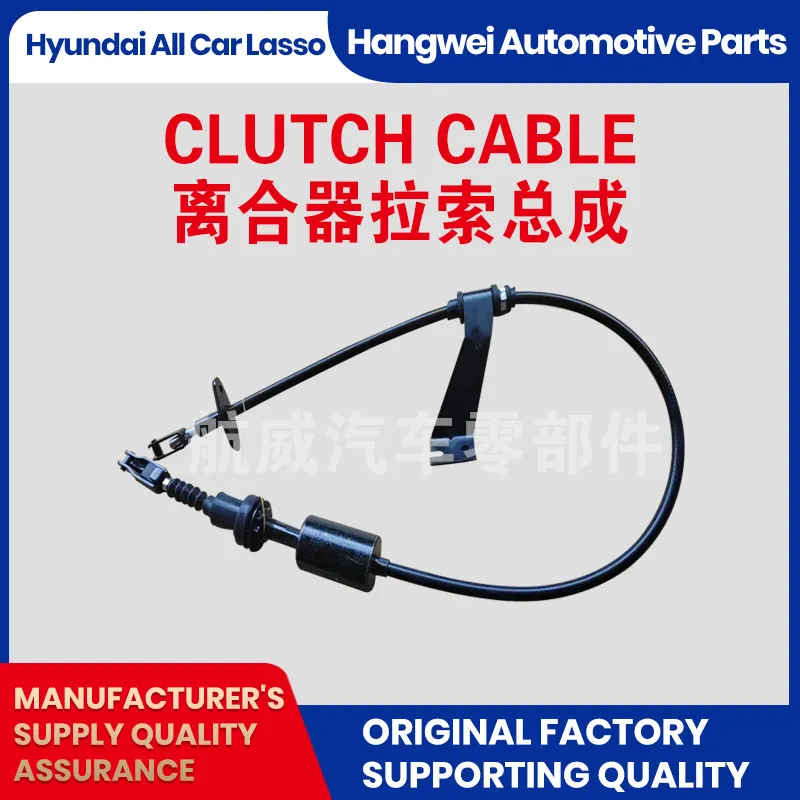Clutch Line | OEM-Fit, High-Pressure, Fast Shipping
Clutch Push-Pull Cable: insider notes from the shop floor
I’ve been around enough driveline projects to know when a clutch line feels right. The pedal’s light, the bite point is repeatable, nothing sticks in winter, and—this matters—maintenance techs don’t curse at it. HWEI Cable’s Clutch Push-Pull Cable, manufactured at Qinghe County, Minjiang Street South, Wuzhishan Road East, hits those notes. It’s not hype; it’s the sort of incremental engineering that quietly saves fleets money. To be honest, cable-operated systems aren’t “trendy,” but they’re still the smart choice in motorcycles, light commercial vehicles, ag machinery, and anywhere simple, robust actuation beats hydraulics.

What’s changing in the market
Electrification grabs headlines, but control cables evolve too. Lower-friction liners (PTFE blends), tighter braid angles, and better corrosion protection are now baseline. OEMs chase longer service intervals and lower NVH. Surprisingly, even premium bikes stick with clutch line systems because they’re lighter, cheaper, and easier to field-service than small-bore hydraulics.
Process flow and quality playbook (how it’s built)
- Materials: high-tensile galvanized or 304/316 stainless inner wire; PTFE low-friction liner; spiral-wound steel conduit; PVC or TPE jacket.
- Methods: controlled strand lay for consistent elongation; precision swaging of end fittings (clevis, eyelet, ball); crimp pull-verification on 100% of lots.
- Testing standards (typical): salt spray per ISO 9227 / ASTM B117; vibration per ISO 16750-3; thermal cycling -40°C to 120°C; life-cycle rigs at rated loads; RoHS/REACH compliance checks.
- Service life: many customers report 200k–400k cycles in the field (real-world use may vary with routing and load).
- Industries: motorcycles, compact cars with manual transmissions, LCVs, forklifts, ag tractors, marine throttles where similar push-pull geometry applies.
Key specifications (typical, customizable)
| Parameter | Spec (≈, customizable) |
|---|---|
| Inner wire | 7×7 or 7×19 galvanized steel or 304/316 SS |
| Liner | PTFE low-friction sleeve, μ ≈ 0.08–0.15 |
| Outer conduit | Steel wound with PVC/TPE jacket |
| Working temp | -40°C to 120°C (up to 150°C with high-heat jacket) |
| Max load | ≈ 800–1,200 N pull (depends on wire Ø and stroke) |
| Bend radius | ≥ 8–10× conduit OD for best life |
Real-world application and quick case
A regional delivery fleet retrofitted clutch line assemblies with PTFE liners and stainless ends for winter routes. Result? About 18% lower pedal force and fewer freeze-up complaints. Maintenance intervals stretched from one season to two. Not glamorous, but the drivers noticed (they told me straight away).
Vendor comparison (what buyers usually ask)
| Criteria | HWEI Cable | Competitor A |
|---|---|---|
| Certifications | IATF 16949/ISO 9001, RoHS, REACH (docs on request) | ISO 9001 only (varies) |
| Life testing | ≥ 300k cycles at 70% rated load (lab), ≈240h salt spray | ≈ 150–200k cycles, 96–120h salt spray |
| Customization | Full: stroke, fittings, jacket, labeling | Limited SKUs |
| Lead time | ≈ 2–4 weeks (project-dependent) | ≈ 5–7 weeks |
| MOQ | Flexible, pilot lots available | Higher MOQ |
Customization menu (what engineers tweak)
- End fittings: clevis, threaded stud, ball/eye, quick-connect.
- Wire: galvanized vs. 304/316 SS; Ø to match load targets.
- Jacket: PVC for cost, TPE for heat, optional textile over-braid.
- Stroke/length: cut-to-length with tolerance targets around ±0.5 mm at end-to-end.
- Labeling and kitting for aftermarket SKUs.
Test data and certifications (in brief)
- Life: lab rigs show 300k–500k cycles depending on routing (customer feedback aligns).
- Corrosion: 240–480 h neutral salt spray possible with stainless ends and enhanced plating.
- Compliance: IATF 16949 quality system; RoHS and REACH material declarations available.
Authoritative citations
- IATF 16949:2016 – Automotive Quality Management System.
- ISO 9227:2017 – Corrosion tests in artificial atmospheres (salt spray).
- ASTM B117 – Standard Practice for Operating Salt Spray (Fog) Apparatus.
- ISO 16750-3 – Road vehicles: Environmental conditions and testing for electrical and mechanical loads.
- Directive 2011/65/EU (RoHS) – Restriction of Hazardous Substances.
- Regulation (EC) No 1907/2006 (REACH) – Registration, Evaluation, Authorisation and Restriction of Chemicals.
-
Clutch Line: Braided, Leak-Proof, OEM-Grade PerformanceNewsNov.10,2025
-
Throttle Cable: Durable, Smooth Control & Universal FitNewsNov.10,2025
-
Throttle Cable: Durable, Smooth, Universal Fit, Easy InstallNewsNov.10,2025
-
Clutch Line: Durable, Leak-Proof, OEM-Grade PerformanceNewsNov.10,2025
-
Hand Brake Cable | Custom, Universal & Trailer SolutionsNewsNov.10,2025
-
Clutch Line: High-Pressure, OEM-Fit, Corrosion-ResistantNewsNov.03,2025
